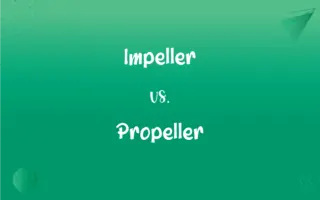GFP vs. EGFP: What's the Difference?
Edited by Aimie Carlson || By Harlon Moss || Published on February 8, 2024
GFP (Green Fluorescent Protein) is a naturally occurring bioluminescent protein, while EGFP (Enhanced Green Fluorescent Protein) is a modified form of GFP with improved brightness and stability.

Key Differences
GFP, or Green Fluorescent Protein, is a protein originally isolated from the jellyfish Aequorea victoria. It naturally emits green light when exposed to blue to ultraviolet light. EGFP, on the other hand, is a derivative of GFP that has been genetically engineered for enhanced fluorescence and expression in various biological systems.
GFP is widely used as a fluorescent marker in biochemistry and cell biology. EGFP, due to its enhanced properties, is preferred for more complex biological applications where higher fluorescence intensity and stability are required.
The basic structure of EGFP is similar to GFP, it has specific amino acid mutations that result in a brighter and more stable fluorescence. This makes EGFP more useful for detailed cellular imaging and molecular biology studies.
GFP has inherent fluorescent properties, but EGFP, due to its modifications, exhibits a higher quantum yield and greater photostability. This means that EGFP maintains its fluorescence intensity better over time and under various experimental conditions.
GFP is used in a wide range of biological research for tracking gene expression and protein localization. EGFP, with its enhanced characteristics, is particularly useful in more demanding applications like live cell imaging, where consistent and prolonged fluorescence is crucial.
ADVERTISEMENT
Comparison Chart
Origin
Natural protein from jellyfish
Genetically modified version of GFP
Fluorescence Intensity
Standard brightness
Enhanced brightness
Stability
Less stable than EGFP
More stable, especially in harsh conditions
Molecular Modifications
None (natural form)
Contains specific mutations for enhancement
Preferred Applications
General fluorescent marking
Demanding applications requiring stable fluorescence
ADVERTISEMENT
GFP and EGFP Definitions
GFP
A bio-marker emitting green light under UV illumination.
The GFP-tagged cells glowed green under the UV microscope.
EGFP
A genetically modified GFP for increased photostability.
The use of EGFP ensured consistent results in prolonged experiments.
GFP
A naturally occurring protein emitting green fluorescence.
Scientists used GFP to track protein movement within cells.
EGFP
An improved GFP variant for complex experimental conditions.
In fluctuating environmental conditions, EGFP proved to be more reliable than GFP.
GFP
A tool for studying gene expression and protein localization.
Using GFP, researchers observed the activation of specific genes in real-time.
EGFP
An enhanced version of GFP with brighter fluorescence.
EGFP was utilized for its superior brightness in cellular imaging studies.
GFP
A fluorescent protein used in various biological research.
GFP tagging helped in identifying the pathways of neuronal development.
EGFP
A fluorescent protein with mutations for better performance.
EGFP's modifications allowed for clearer visualization in dense tissue samples.
GFP
A bioluminescent marker from Aequorea victoria jellyfish.
GFP revolutionized cell biology by enabling visualization of cellular processes.
EGFP
A tool for advanced biological research requiring stable fluorescence.
Researchers preferred EGFP for live-cell imaging due to its enhanced stability.
FAQs
What does GFP stand for?
GFP stands for Green Fluorescent Protein.
What is EGFP?
EGFP is Enhanced Green Fluorescent Protein, a modified version of GFP.
Why is GFP important in biological research?
GFP is a crucial tool for visualizing and studying biological processes in cells.
Where was GFP originally discovered?
GFP was discovered in the jellyfish Aequorea victoria.
What are the key modifications in EGFP?
EGFP contains specific amino acid mutations for enhanced brightness and stability.
How does GFP emit green light?
GFP emits green light when it is excited by blue or ultraviolet light.
Can GFP be used in live cell imaging?
Yes, GFP can be used in live cell imaging, but EGFP is often better due to its stability.
Is EGFP used in genetic engineering?
Yes, EGFP is widely used in genetic engineering and molecular biology.
What makes EGFP preferable over GFP in some studies?
EGFP's enhanced fluorescence and stability make it suitable for more demanding research.
Can GFP be expressed in all types of cells?
GFP can be expressed in many cell types, but not universally in all.
Does EGFP emit brighter light than GFP?
Yes, EGFP emits brighter light due to its enhanced properties.
Is EGFP naturally occurring?
No, EGFP is a genetically engineered protein.
What is the role of GFP in gene expression studies?
GFP acts as a marker, indicating the expression of certain genes.
How has GFP impacted scientific research?
GFP has revolutionized biological research by allowing direct observation of cellular processes.
Are GFP and EGFP used outside of cell biology?
Yes, they are also used in various fields, including developmental biology and neurology.
Can GFP be seen with the naked eye?
GFP requires UV or blue light excitation to be visible, typically observed under a microscope.
How does EGFP improve upon GFP?
EGFP improves fluorescence intensity and photostability, making it more effective for detailed studies.
Are there any risks associated with using GFP?
GFP is generally considered safe, but its use should be carefully controlled in lab settings.
Why are the mutations in EGFP significant?
The mutations in EGFP enhance its fluorescent properties, making it more useful in research.
Does EGFP change the function of the proteins it's attached to?
EGFP usually does not significantly alter the function of the proteins it is fused with.
About Author
Written by
Harlon MossHarlon is a seasoned quality moderator and accomplished content writer for Difference Wiki. An alumnus of the prestigious University of California, he earned his degree in Computer Science. Leveraging his academic background, Harlon brings a meticulous and informed perspective to his work, ensuring content accuracy and excellence.
Edited by
Aimie CarlsonAimie Carlson, holding a master's degree in English literature, is a fervent English language enthusiast. She lends her writing talents to Difference Wiki, a prominent website that specializes in comparisons, offering readers insightful analyses that both captivate and inform.







































































